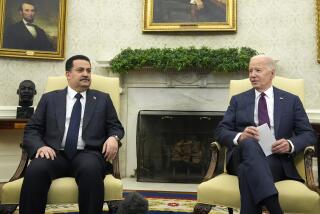A life and legacy marked by violence
- Share via
Childhood
1937: Saddam Hussein was born April 28 to a family of peasants in the village of Al Auja, near the town of Tikrit, 100 miles north of Baghdad. His father left before his birth. When he was 10, he went to live with his uncle, Khayrallah Tulfah. A former Iraqi general who was a fascist and anti-Western, Tulfah had an ideological influence on the young Saddam.
*
Gang leader
1950s: At 19, Hussein led a street gang of fellow Tikritis and participated in a coup attempt against Iraq’s King Faisal II. The coup failed, but Hussein was well on his way to becoming a feared figure in the Iraqi underground. A year later, he joined the Iraqi branch of the Baathist Party, a secular, pan-Arabist political movement that combined elements of socialism and Nazism.
*
Baathist coup
1963: The Baathists overthrew Gen. Abdul Karim Kassim, leader of the 1958 coup that toppled Iraq’s monarchy. Hussein, then 26, reportedly became the new regime’s chief torturer as the head of an interrogation center known as the Palace of the End. The Baathists were overthrown a few months later, and Hussein was imprisoned for two years before escaping.
*
A second takeover
1968: The Baathists seized power a second time, installing Gen. Ahmed Hassan Bakr, the party’s secretary-general, as president. Hussein expanded his power base as head of the new internal security apparatus. He eased Bakr out of office and assumed the presidency in 1979.
*
Iran-Iraq War
1980: In September, Iraq invaded Iran. That war lasted eight years and claimed
1 million lives. The war probably would have been lost by Iraq if it had not been for U.S. intelligence and billions in Arab aid.
1981: In June, Israeli planes destroyed a reactor near Baghdad that would have enabled Hussein to manufacture nuclear arms.
*
Attack on Kurds
Late 1980s: Iraqi air force helicopters dropped chemical weapons on cities in northern Iraq that were heavily populated by Kurdish rebels who had been waging a decades-long war for a separatist homeland. The chemical agents were thought to have been cyanide and mustard gas, and the death toll was believed to have been in the thousands.
*
Persian Gulf War
Early 1990s: Hussein ordered his troops to invaded Kuwait in August 1990. Operation Desert Storm, a campaign led by the U.S., began Jan. 17, 1991, with massive air attacks on Baghdad and Iraqi military facilities. It ended with a 100-hour ground war.
*
Growing isolation
Late 1990s: In 1998, Hussein expelled U.N. inspectors who had been scouring Iraq for weapons of mass destruction. Iraq, once one of the most prosperous Arab countries, had sunk into economic ruin. U.S. and British continued to enforce “no-fly” zones to protect Kurds in the north and Shiite Muslims in the south.
2000: Hussein, worth $7 billion, ranked 55th on the Forbes’ richest people list. The U.S. called for a special war crimes tribunal to try Hussein.
March 20, 2003: After months of contention over U.S. claims that Iraq possessed weapons of mass destruction, the U.S.-led war against Iraq began.
*
The hunt for Hussein
March 20, 2003: On the opening day of the war, 40 Tomahawk missiles were fired on Dora Farms, south of Baghdad, where Hussein and his sons were said to be. Later in the day, Hussein appeared on Iraqi TV.
March 24: Hussein appeared on TV again.
April 4: Iraqi TV showed video of Hussein walking on a Baghdad street.
April 7: U.S. warplanes bombed a section of the Mansour district in Baghdad where Hussein and sons were said to be meeting.
April 9: Crowds greeted U.S. troops in Baghdad, and toppled 40-foot statue of Hussein.
April 18: Audio and video recordings of Hussein surfaced, purportedly made April 9.
July 4: The CIA said the July 4
Al Jazeera TV audiotape of Hussein saying he was still in Iraq and directing attacks was “most likely his [Hussein’s] voice.”
July 17: Arab TV aired audiotape purportedly of Hussein denouncing Iraq’s newly formed Governing Council.
July 22: Hussein’s sons Qusai and Uday were killed in a gun battle with U.S. troops. Shortly after the raid, U.S. troops came up short in a raid looking for Hussein in Mosul, saying, “We missed him by a matter of hours.”
July 27, predawn: U.S. troops raided three farms in Tikrit, again announcing they missed Hussein by 24 hours. Although not confirmed by the military, witnesses reported that soldiers that evening raided the home of a tribal leader in Baghdad looking for Hussein.
July 29: Iraqi TV aired audiotape of Hussein acknowledging his sons’ deaths; the CIA said
it was authentic.
Aug. 1: Another audiotape issued a new call to arms against U.S. forces; the CIA authenticated it.
Dec. 13, 8:30 p.m. local time: Saddam Hussein was found hiding in a pit camouflaged with bricks and dirt in Ad Dawr.
*
Source: Associated Press
More to Read
Sign up for Essential California
The most important California stories and recommendations in your inbox every morning.
You may occasionally receive promotional content from the Los Angeles Times.













